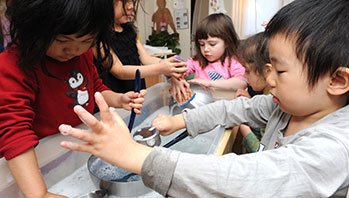- camera or cell phone with camera
- crayons/markers
- magnifying lenses
- nonstandard measuring tools
- paper
- plastic plates
- scales
- toothpicks
- whole and sliced fruits and vegetables (e.g., avocado, banana, melon, peas, olive with pit, orange, peach, apple, pepper, tomato, kiwi)
- aroma
- fruit
- seed
- vegetable
MA Standards:
Language/L.PK.MA.6: Use words and phrases acquired through conversations, listening to books read aloud, activities, and play.
MA Draft STE Standards:
Life Sciences/From Molecules to Organisms: Inheritance and Variation of Traits/LS1/3.A: Describe/draw and compare the body parts of animals (including themselves) and plants they are investigating [System] and explain functions of some of the observable body parts. [Structure and Function]
Life Sciences/From Molecules to Organisms: Inheritance and Variation of Traits/LS1/3.C: Use their sense in their exploration and play to gather information. [Structure and Function]
Head Start Outcomes:
Logic and Reasoning/Reasoning and Problem Solving: Classifies, compares, and contrasts objects, events, and experiences.
Science Knowledge/Scientific Skills and Method: Observes and discusses common properties, differences, and comparisons among objects.
Science Knowledge/Scientific Skills and Method: Collects, describes, and records information through discussions, drawings, maps, and charts.
PreK Learning Guidelines:
English Language Arts/Language 2: Participate actively in discussions, listen to the ideas of others, and ask and answer relevant questions.
Science and Technology/Inquiry Skills 4: Record observations and share ideas through simple forms of representation such as drawings.
Explore Together (indoors): Explore Fruits, Vegetables, Seeds

© Commonwealth of Massachusetts, Department of Early Education and Care (Jennifer Waddell photographer). All rights reserved.
STEM Key Concepts: Many foods that animals, including humans, eat come from plants; We eat certain leaves, roots, fruits, and seeds; Fruits have seeds; Seeds hold what a plant needs to make more of itself
ELA Focus Skills: Compare and Contrast, Listening and Speaking, Vocabulary
Educator Prep: Prepare an area by spreading the fruits and vegetables out so children can explore individually and with one another.
- Prepare plates of small pieces of each food for children to sample as they explore. Include a whole fruit/vegetable for comparison.
- Save some fruit and vegetable slices for Small Group activity.
Safety Tips:
- Remind children to wash their hands before and after the activity.
- Take children’s dietary needs into account before introducing them to any food items.
Direct children’s attention to the fruits and vegetables and tell them they are going to freely explore the fruits, vegetables, and seeds. Distribute magnifying lenses. Allow children to taste one slice of each kind of food as they explore. Encourage children to compare by categories such as size, shape, texture, aroma, or color. Circulate and engage children to expand their interest. Ask questions such as,
- How is the aroma of the whole banana different from the aroma of the banana slices?
- How are the seeds in the kiwi different from the seeds in the green pepper? (hard/soft, black/white, size)
Have children draw a picture to illustrate something they learned while observing. Encourage them to dictate or write a caption.
Reflect and Share
Talk about children’s findings. Have them share their drawings and describe what they observed. Ask questions such as,
- What is different about the seeds in the kiwi compared to the seeds in the melon? (rows/cluster) What about the olive? (one in the middle)
- Why do you think the aroma of the fruits is stronger when we slice them open? Was that the same with the root and leaf vegetables when we sliced them?
- When we want to eat a melon, we slice it open. How do you think an animal would eat a melon? (bite it open/eat the skin/throw it on the ground)
